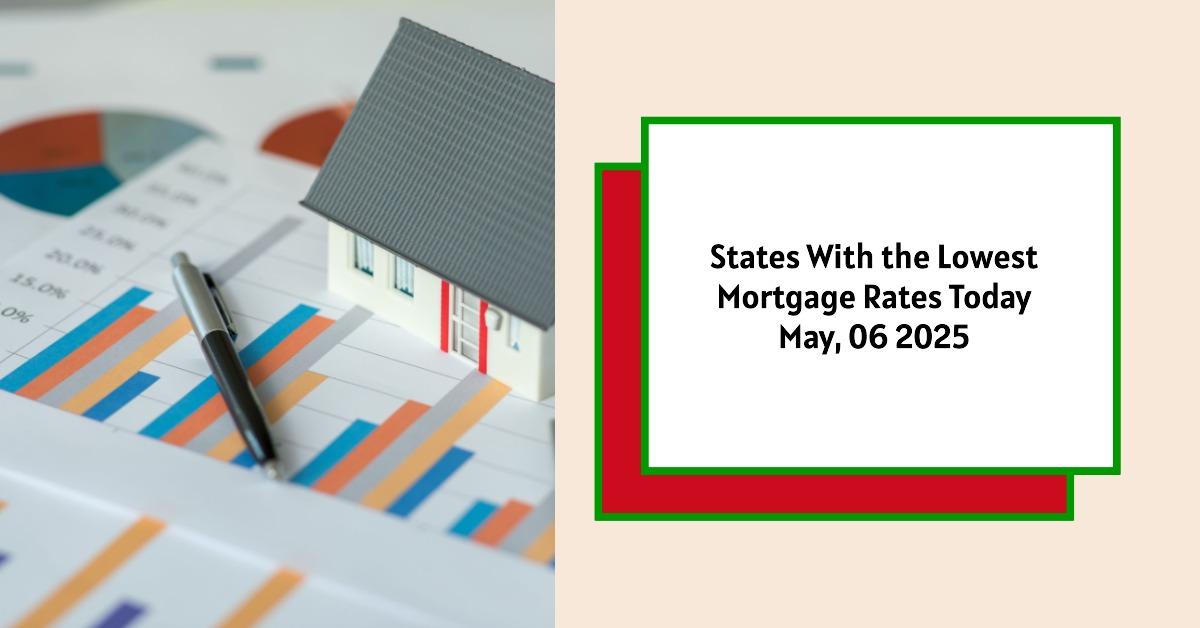If you're looking for the states with the lowest mortgage rates today, May 6, 2025, the answer is: New York, California, Florida, Missouri, Texas, Washington, and North Carolina. These states currently boast the cheapest 30-year new purchase mortgage rates, with averages ranging from 6.77% to 6.98%, according to data by Zillow.
Buying a home is a huge decision, and understanding mortgage rates is a crucial part of the process. Let's dive deeper into what's driving these rates and where you can find the best deals.
States With the Lowest Mortgage Rates Today – May, 06 2025
National Mortgage Rate Snapshot
Before we zoom in on the states with the lowest rates, let's get a national overview. As of today, May 6, 2025, the national average for a 30-year fixed-rate mortgage is 7.00%. This represents a slight increase from the end of last week. Here's a quick look at the national averages for different loan types:
| Loan Type | New Purchase Rate |
|---|---|
| 30-Year Fixed | 7.00% |
| FHA 30-Year Fixed | 7.45% |
| 15-Year Fixed | 6.03% |
| Jumbo 30-Year Fixed | 6.95% |
| 5/6 ARM | 7.24% |
Source: Zillow
It's worth noting that these are just averages. The actual rate you get will depend on your individual circumstances, including your credit score, down payment, and debt-to-income ratio.
The States With the Sweetest Deals
As mentioned earlier, New York, California, Florida, Missouri, Texas, Washington, and North Carolina are the states offering the lowest mortgage rates right now. Let’s take a closer look at each:
- New York: Known for its competitive financial sector, New York often sees lower rates due to the presence of numerous lenders.
- California: Despite its high home prices, California’s large market volume can lead to more competitive rates.
- Florida: A popular destination for retirees and new residents, Florida's robust housing market keeps rates competitive.
- Missouri: With a more affordable housing market compared to coastal states, Missouri can offer attractive rates.
- Texas: The Lone Star State's booming economy and population growth drive competition among lenders.
- Washington: Home to tech giants and a thriving job market, Washington's stable economy contributes to favorable rates.
- North Carolina: With a growing population and diverse economy, North Carolina offers a good balance of affordability and opportunity.
The common factor among these states appears to be a combination of a strong housing market and active competition among lenders, or a more affordable housing market, which helps drive mortgage rates down.
States Where Mortgage Rates Are Higher
On the flip side, some states are seeing higher mortgage rates today. According to Zillow, the states with the highest rates include:
- Alaska
- West Virginia
- Maine
- Rhode Island
- Washington, D.C.
- South Dakota
- Arizona
- Massachusetts
These states registered averages between 7.04% to 7.16%.
It's important to understand that there's no single reason why rates are higher in these areas. Factors like lower population density (which can lead to less competition), varying state regulations, and regional economic conditions can all play a role.
Why Do Mortgage Rates Vary by State?
You might be wondering, why are mortgage rates different in different states? There are several reasons:
- Lender Presence: Not all lenders operate in every state. The level of competition among lenders can significantly impact rates.
- Credit Scores: Average credit scores vary by state. States with higher average credit scores may see lower rates overall.
- Loan Size: The average loan size also differs from state to state. Larger loans might sometimes come with slightly different rates.
- State Regulations: Some states have specific regulations that can influence mortgage rates.
- Risk Management: Lenders have different risk management strategies, which can affect the rates they offer in certain areas.
What's Driving Mortgage Rate Fluctuations?
Mortgage rates are a moving target, influenced by a complex interplay of economic factors. Here's a breakdown of the key drivers:
- The Bond Market: Mortgage rates are closely tied to the 10-year Treasury yield. When Treasury yields rise, mortgage rates typically follow suit.
- Federal Reserve Policy: The Federal Reserve's monetary policy, particularly its bond-buying programs and decisions about the federal funds rate, has a significant impact on mortgage rates. The Fed can directly influence short-term interest rates, and while it doesn't directly control mortgage rates, its actions certainly have an impact on the broader economy and investor sentiment.
- Inflation: Inflation is a big one! When inflation is high, investors demand higher returns on their investments, which pushes up interest rates. We saw this play out dramatically in 2022 and 2023.
- Economic Growth: A strong economy typically leads to higher interest rates, as demand for credit increases.
- Housing Market Conditions: The overall health of the housing market, including factors like home sales, inventory levels, and demand, can also influence mortgage rates.
The Fed's Role and Future Rate Cuts
The Federal Reserve's actions are particularly important to watch. After aggressively raising interest rates in 2022 and 2023 to combat inflation, the Fed began to ease up in late 2024. However, the central bank opted to hold rates steady for its first meeting of the new year, and it's possible they may not make another rate cut for months. We could see multiple rate-hold announcements in 2025.
It's really difficult to predict exactly what the Fed will do. Their decisions will depend on how the economy performs and whether inflation continues to cool down. I'm personally hoping to see at least a couple of rate cuts this year, but it's all up in the air.
Read More:
States With the Lowest Mortgage Rates on May 5, 2025
How to Get the Best Mortgage Rate
Regardless of where you live, there are steps you can take to secure the best possible mortgage rate:
- Improve Your Credit Score: A higher credit score typically translates to a lower interest rate. Check your credit report for errors and take steps to improve your score if necessary.
- Save for a Larger Down Payment: A larger down payment reduces the lender's risk and can result in a lower rate. Aim for at least 20% if possible.
- Shop Around: Don't settle for the first rate you're offered. Get quotes from multiple lenders and compare them carefully.
- Consider Different Loan Types: Explore different loan options, such as fixed-rate mortgages, adjustable-rate mortgages (ARMs), and FHA loans, to see which one best suits your needs.
- Negotiate: Don't be afraid to negotiate with lenders. They may be willing to lower their rates or fees to earn your business.
Understanding Teaser Rates
Be cautious of advertised “teaser rates” that seem too good to be true. These rates often come with hidden costs or restrictions, such as paying points upfront or requiring an ultra-high credit score. Focus on finding a rate that's realistic for your individual circumstances.
Calculate Your Potential Monthly Payment
Understanding how different interest rates and loan terms will affect your monthly payment is crucial for budgeting purposes. Using a mortgage calculator, you can estimate your payments based on various scenarios. Here's an example:
- Home Price: $440,000
- Down Payment: $88,000 (20%)
- Loan Term: 30 years
- APR: 6.67%
Based on these figures, your estimated monthly payment would be around $2,649.04. This includes principal, interest, property taxes, and homeowners insurance.
The Bottom Line
Mortgage rates are constantly changing, and what's true today might not be true tomorrow. Keeping an eye on the market and understanding the factors that influence rates is crucial for making informed decisions.
While New York, California, Florida, Missouri, Texas, Washington, and North Carolina are currently offering some of the lowest rates, don't assume that these are the only places to find a good deal. Shop around, compare your options, and don't be afraid to negotiate. With a little effort, you can find a mortgage that fits your needs and budget. Good luck!
Work With Norada, Your Trusted Source for
Real Estate Investment in the U.S.
Investing in turnkey real estate can help you secure consistent returns with fluctuating mortgage rates.
Expand your portfolio confidently, even in a shifting interest rate environment.
Speak with our expert investment counselors (No Obligation):
(800) 611-3060
Also Read:
- Will Mortgage Rates Go Down in 2025: Morgan Stanley's Forecast
- Expect High Mortgage Rates Until 2026: Fannie Mae's 2-Year Forecast
- Mortgage Rate Predictions 2025 from 4 Leading Housing Experts
- Mortgage Rates Forecast for the Next 3 Years: 2025 to 2027
- 30-Year Mortgage Rate Forecast for the Next 5 Years
- 15-Year Mortgage Rate Forecast for the Next 5 Years
- Why Are Mortgage Rates Going Up in 2025: Will Rates Drop?
- Why Are Mortgage Rates So High and Predictions for 2025
- Will Mortgage Rates Ever Be 3% Again in the Future?
- Mortgage Rates Predictions for Next 2 Years
- Mortgage Rate Predictions for Next 5 Years
- Mortgage Rate Predictions: Why 2% and 3% Rates are Out of Reach
- How Lower Mortgage Rates Can Save You Thousands?
- How to Get a Low Mortgage Interest Rate?
- Will Mortgage Rates Ever Be 4% Again?



